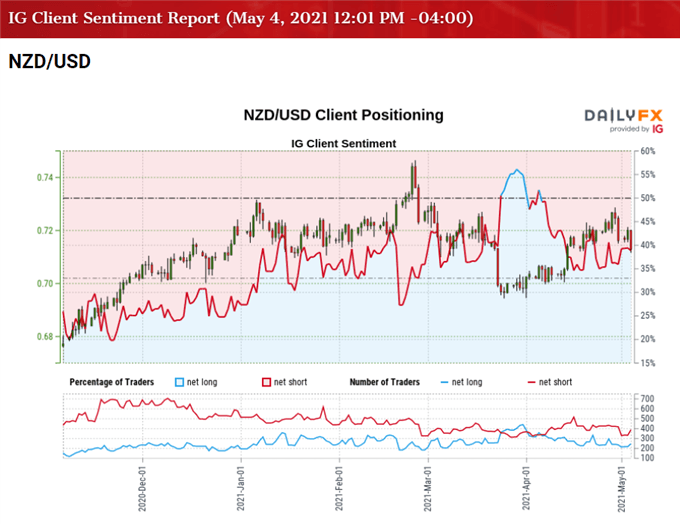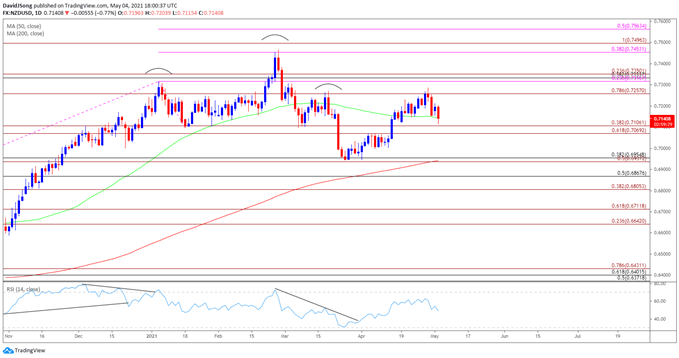New Zealand Dollar Talking Points
NZD/USD has slipped back below the 50-Day SMA (0.7143) after failing to push above the March high (0.7307), and the update to New Zealand’s Employment report may keep the exchange rate confined within a defined range as the fresh figures are anticipated to show a slowing recovery in the labor market.
NZD/USD Confined by March Range Ahead of New Zealand Employment Report
NZD/USD appears to be confined by the March range as it attempts to negate the head-and-shoulders formation from earlier this year, and failure to hold above the 50-Day SMA (0.7143) may push the exchange rate towards the March low (0.6943) as it initiates a series of lower highs and lows.
It remains to be seen if New Zealand’s Employment report will influence the near-term outlook for NZD/USD as job growth is expect to narrow to 0.2% from 0.6% in the fourth quarter of 2020, but signs of a slowing recovery may put pressure on the Reserve Bank of New Zealand (RBNZ) to further support the economy as “short-term data continues to be highly variable as a result of the economic impacts of COVID-19.”
As a result, the RBNZ may continue to offer a dovish forward guidance as “the Committee agreed that medium-term inflation and employment would likely remain below its remit targets in the absence of prolonged monetary stimulus,” and Governor Adrian Orr and Co. may keep the door open to implement a negative interest rate policy (NIRP) as “the Committee agreed that it was prepared to lower the Official Cash Rate (OCR) if required.”
In turn, the New Zealand Dollar may face headwinds ahead of the RBNZ meeting on May 26 as the central bank relies on its non-standard tools to achieve its policy targets, but the decline from the yearly high (0.7465) may turn out to be a correction in the broader trend rather than a key reversal as NZD/USD attempts to negate the head-and-shoulders formation.
At the same time, the recent recovery in NZD/USD has brought back the crowding behavior seen in 2020 as the IG Client Sentiment report shows 38.12% of traders currently net-long the pair, with the ratio of traders short to long standing at 1.62 to 1.
The number of traders net-long is 10.32% lower than yesterday and 4.55% lower from last week, while the number of traders net-short is 12.05% higher than yesterday and 8.30% lower from last week. The decline in net-long position comes as NZD/USD fails to test the March high (0.7307), while the decline in net-short position has eased the tilt in retail sentiment as 37.18% of traders were net-long the pair during the previous week.
With that said, the decline from the yearly high (0.7465) may turn out to be a correction in the broader trend rather than a key reversal as the crowding behavior from 2020 resurfaces, butlack of momentum to hold above the 50-Day SMA (0.7143) may push the exchange rate towards the March low (0.6943) as it initiates a series of lower highs and lows.
NZD/USD Rate Daily Chart
Source: Trading View
- A head-and-shoulders formation materialized in 2021 as NZD/USD slipped below the 50-Day SMA (0.7143) for the first time November, but the decline from the yearly high (0.7465) may turn out to be a correction in the broader trend rather than a key reversal as the exchange rate trades back above the neckline.
- The Relative Strength Index (RSI) highlights a similar dynamic as it reversed ahead of oversold territory to break out of the downward trend from earlier this year, but the failed attempt to test the March high (0.7307) may keep NZD/USD within a defined range as it appears to be negating the head-and-shoulders formation from earlier this year.
- Lack of momentum to hold above the 50-Day SMA (0.7143) may push NZD/USD back below the Fibonacci overlap around 0.7070 (61.8% expansion) to 0.7110 (38.2% expansion), with the next area of interest coming in around 0.6940 (50% expansion) to 0.6960 (38.2% retracement), which lines up with the March low (0.6943).
— Written by David Song, Currency Strategist
Follow me on Twitter at @DavidJSong




Be the first to comment